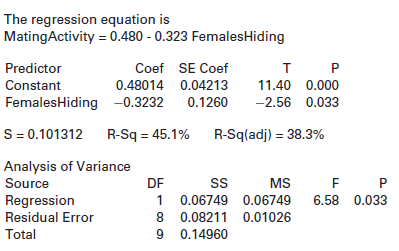In Exercise A.46 on page 153, we introduce a study about mating activity of water striders. The
Question:


(a) While it is hard to tell with only n = 10 data points, determine whether we should have any serious concerns about the conditions for fitting a linear model to these data.
(b) Write down the equation of the least squares line and use it to predict the mating activity of water striders in a group in which females spend 50% of the time in hiding (FemalesHiding = 0.50).
(c) Give the hypotheses, t-statistic, p-value, and conclusion of the t-test of the slope to determine whether time in hiding is an effective predictor of mating activity.
(d) Give the hypotheses, F-statistic, p-value, and conclusion of the ANOVA test to determine whether the regression model is effective at predicting mating activity.
(e) How do the two p-values from parts (c) and (d) compare?
(f) Interpret R2 for this model.
Exercise A.46 on page 153
If a male wants mating success, he should not hang out with hyper-aggressive males. They tend to scare away all the females. At least, that is the message from a study on water striders. Water striders are common bugs that skate across the surface of water. Water striders have different personalities and some of the males are hyper-aggressive, meaning they jump on and wrestle with any other water strider near them. Individually, because hyper-aggressive males are much more active, they tend to have better mating success than more inactive striders. This study examined the effect they have on a group. Four males and three females were put in each of ten pools of water. Half of the groups had a hyperaggressive male as one of the males and half did not. The proportion of time females are in hiding was measured for each of the 10 groups, and a measure of mean mating activity was also measured with higher numbers meaning more mating. Results are shown in Table A.11 and are available in WaterStriders.
Table A.11

Step by Step Answer:

Statistics Unlocking The Power Of Data
ISBN: 9780470601877
1st Edition
Authors: Robin H. Lock, Patti Frazer Lock, Kari Lock Morgan, Eric F. Lock, Dennis F. Lock





